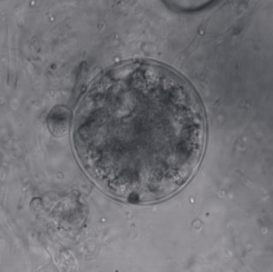
Chytridiomycota are a division of zoosporic organisms in the kingdom Fungi, informally known as chytrids. The name is derived from the Ancient Greek χυτρίδιον, meaning "little pot", describing the structure containing unreleased zoospores. Chytrids are one of the earliest diverging fungal lineages, and their membership in kingdom Fungi is demonstrated with chitin cell walls, a posterior whiplash flagellum, absorptive nutrition, use of glycogen as an energy storage compound, and synthesis of lysine by the α-amino adipic acid (AAA) pathway.

Eurotiomycetes is a large class of ascomycetes with cleistothecial ascocarps within the subphylum Pezizomycotina, currently containing around 3810 species according to the Catalogue of Life. It is the third largest lichenized class, with more than 1200 lichen species that are mostly bitunicate in the formation of asci. It contains most of the fungi previously known morphologically as "Plectomycetes".

The Eurotiales are an order of sac fungi, also known as the green and blue molds. It was circumscribed in 1980.

The Hypocreales are an order of fungi within the class Sordariomycetes. In 2008, it was estimated that it contained some 237 genera, and 2647 species in seven families. Since then, a considerable number of further taxa have been identified, including an additional family, the Stachybotryaceae. Wijayawardene et al. in 2020 added more families and genera to the order. According to the Catalog of Life, As of April 2021 the Hypocreales contains 6 families, 137 genera, and 1411 species. Hyde et al. (2020a) listed 14 families under Hypocreales, while, Wijayawardene et al. (2022) accepted 15 families in the order, where Cylindriaceae was additionally added. Earlier, Hyde et al. (2020a) had placed Cylindriaceae in class Xylariomycetidae. Samarakoon et al. (2022) agreed. Hence, Cylindriaceae should have been excluded from Hypocreales and placed in Xylariomycetidae. Xiao et al. (2022) recently introduced a new family Polycephalomycetaceae to Hypocreales.

Endogonales is an order of fungi within the phylum of Zygomycota, and in class Endogonomycetes.

Rhizophydiales are an important group of chytrid fungi. They are found in soil as well as marine and fresh water habitats where they function as parasites and decomposers.

Blastocladiomycota is one of the currently recognized phyla within the kingdom Fungi. Blastocladiomycota was originally the order Blastocladiales within the phylum Chytridiomycota until molecular and zoospore ultrastructural characters were used to demonstrate it was not monophyletic with Chytridiomycota. The order was first erected by Petersen for a single genus, Blastocladia, which was originally considered a member of the oomycetes. Accordingly, members of Blastocladiomycota are often referred to colloquially as "chytrids." However, some feel "chytrid" should refer only to members of Chytridiomycota. Thus, members of Blastocladiomyota are commonly called "blastoclads" by mycologists. Alternatively, members of Blastocladiomycota, Chytridiomycota, and Neocallimastigomycota lumped together as the zoosporic true fungi. Blastocladiomycota contains 5 families and approximately 12 genera. This early diverging branch of kingdom Fungi is the first to exhibit alternation of generations. As well, two (once) popular model organisms—Allomyces macrogynus and Blastocladiella emersonii—belong to this phylum.

The Botryosphaeriales are an order of sac fungi (Ascomycetes), placed under class Dothideomycetes. Some species are parasites, causing leaf spot, plant rot, die-back or cankers, but they can also be saprophytes or endophytes. They occur world-wide on many hosts. For example, in China, infections related to Botryosphaeriales have been recorded on numerous hosts such as grapes, Caragana arborescens,Cercis chinensis, Eucalyptus, Chinese hackberry, blueberry, forest trees, and various other woody hosts.

The Pyronemataceae are a family of fungi in the order Pezizales. It is the largest family of the Pezizales, encompassing 75 genera and approximately 500 species. Phylogenetic analyses does not support the prior classifications of this family, and suggest that the family is not monophyletic as it is currently circumscribed.

Chrysotrichaceae is a family of lichenized fungi in the order Arthoniales. Member of this family have a widespread distribution, but are especially prevalent in tropical areas. "Chrysothrichaceae" and "Chrysothricaceae" are alternative spellings that have been used in some older publications; the latter was used by Alexander Zahlbruckner in the protologue publication. Both of these spellings are considered incorrect, and the current spelling has been formalised following a proposal for conservation of Chrysotrichaceae against Pulverariaceae.
The Didymosphaeriaceae are a family of fungi in the order Pleosporales. The family was erected by Anders Munk in 1953.

Lichinales is the sole order of ascomycete fungi in the class Lichinomycetes. It contains three families: Gloeoheppiaceae, Lichinaceae, and Peltulaceae. Most species are lichenized. Lichinales was proposed in 1986 by German lichenologists Aino Henssen and Burkhard Büdel. The class Lichinomycetes was created by Valérie Reeb, François Lutzoni and Claude Roux in 2004.

The Pyrenulales are an order of ascomycetous fungi within the class Eurotiomycetes and within the subphylum Pezizomycotina.

Kickxellomycotina is a fungus grouping. In the subkingdom of Zoopagomyceta Benny, 2007.

The Onygenaceae are a family of fungi in the Ascomycota, class Eurotiomycetes.

The Anthracoideaceae are a family of smut fungi in the order Ustilaginales. Collectively, the family contains 20 genera and 198 species. Anthracoideaceae was circumscribed by the Bulgarian mycologist Cvetomir M. Denchev in 1997.
The Cladochytriaceae are a family of fungi in the order Cladochytriales.
Nowakowskiella is the sole genus of fungi in the family Nowakowskiellaceae. The genus was circumscribed by German mycologist Joseph Schröter in 1897, while the family was originally circumscribed by Frederick Kroeber Sparrow in 1942, and then published validly in 2009.
Hyaloraphidium is a genus of chytrid-like fungi. It is the only member of the family Hyaloraphidiaceae, order Hyaloraphidiales and class Hyaloraphidiomycetes in the division Monoblepharomycota.

The plasmodiophores are a group of obligate endoparasitic protists belonging to the subphylum Endomyxa in Cercozoa. Taxonomically, they are united under a single family Plasmodiophoridae, order Plasmodiophorida, sister to the phagomyxids.















